Physical activity
Last Modified 19/04/2022 14:20:05
Share this page
Introduction
Physical inactivity is the 4th leading risk factor for global mortality accounting for 6% of deaths globally. People who have a physically active lifestyle have a 20-35% lower risk of cardiovascular disease, coronary heart disease and stroke compared to those who have a sedentary lifestyle. Regular physical activity is also associated with a reduced risk of diabetes, obesity, coronary heart disease, osteoporosis, and colon/breast cancer, and with improved mental health and reduced social isolation. In older adults physical activity is associated with increased functional capacities. In children, regular exercise is associated with improved learning and educational attainment, mental health, cardiovascular fitness and healthy weight status1,2.
The Chief Medical Officer (CMO) recommends that adults undertake a minimum of 150 minutes (2.5 hours) of moderate physical activity per week; or 75 minutes of vigorous physical activity (such as running) per week; or even shorter durations of very vigorous intensity activity (such as sprinting or stair climbing); or a combination of moderate, vigorous and very vigorous intensity activity (figure 1). Adults should also aim to minimise the amount of time spent being sedentary, and when physically possible should break up long periods of inactivity with at least light physical activity.2
Figure 1: Physical activity guidelines for adults
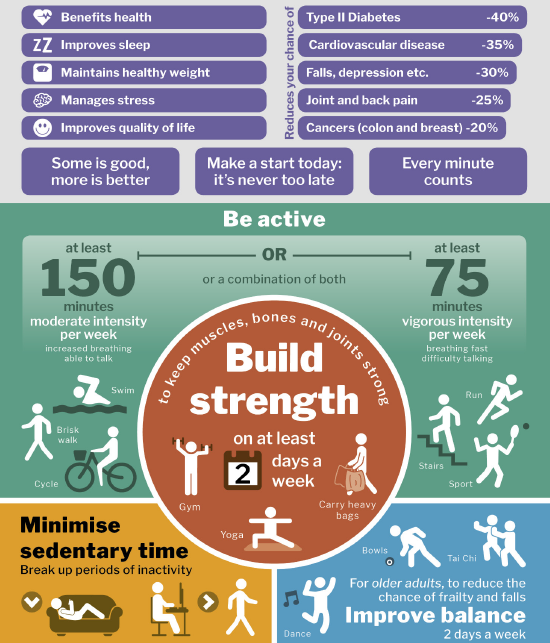 Source: Department of Health & Social Care et al, UK Chief Medical Officers' Physical Activity Guidelines, 2019
Source: Department of Health & Social Care et al, UK Chief Medical Officers' Physical Activity Guidelines, 2019
The Active Lives Adult Survey5, conducted by Sport England, is a sample-based survey conducted across England to measure the number of people taking part in sport and physical activity twice a year. In 2019/20 the survey identified that across England 68% of males and 65% of females aged 19+ were doing at least 150 hours of moderate intensity equivalent minutes per week. 22% of males and 24% of females were physically inactive, doing less than 30 moderate intensity minutes of physical activity per week1. While increasing the activity levels of all adults who are not meeting the recommendations is important, targeting those adults who are significantly inactive (that is, engaging in less than 30 minutes of activity per week) will produce the greatest reduction in chronic disease.2
In 2019/20, among children aged 5-16 years in England, 49% of boys and 57% of girls did not meet the CMOs' recommendations of being physically active for an average of at least 60 minutes per day across the week.1,2
Public Health England (PHE) has co-produced the 'Everybody active, every day' framework3, a national, evidence-based approach to support all sectors to embed physical activity into the fabric of daily life and make it an easy, cost-effective and 'normal' choice in every community in England. The key outcomes within the public health outcomes framework (PHOF) are central to the success of this approach, ie, the percentage of adults physically inactive and physically active.
Current physical activity guidelines
New physical activity guidelines were introduced in 2019 setting out the volume, duration, frequency and type of activity required across the life course to achieve general health benefits. These guidelines updated the existing guidelines for adults, children and young people, early years (under 5's - infants who are not yet walking and children capable of walking), older people (65+ years), disabled adults ,and pregnant women. The guidelines allow for more flexibility in achieving recommended levels of physical activity and recognise the potential benefits of "small behavioural changes and tailored messages to address inequalities"2.
PHE have produced a range of infographics explaining the physical activity required to achieve general health benefits for different age ranges. For further information visit Start active, stay active: infographics on physical activity.
Facts and figures
Adults
While Blackpool has significantly lower levels of physical activity than the national average, the town is similar to national trends in the demographics of physical activity participation; younger people are more active than their older counterparts, men are more active than women, and activity levels are lower in those who have a limiting illness or disability.
Local Active Lives data for 2019/20 also indicates that there is a strong correlation between participation and social class. Within Blackpool, people in the lower socio-economic classifications (NS-SEC) are more inactive (44.1%) than those in the higher socio-economic classifications (21.9%). Correspondingly, physical activity levels are higher in the higher socio-economic classifications (61.6%) than in lower socio-economic groups (44.1%). On a national level, levels of activity and inactivity are similarly linked to socio-economic status and indices of multiple deprivation5.
PHE estimates based on the Sport England Active Lives Survey in 2019/20 suggest that in Blackpool:
-
- Significantly fewer adults are achieving the recommended amount of physical activity per week (150 minutes of at least moderate activity) compared to the national average (figure 2)
- Significantly more adults are classed as inactive, that is, doing less than 30 minutes of moderate intensity physical activity per week (figure 2)
Figure 2: Physical activity - percent of adults active and inactive in Blackpool, the North West and England: 2019/20
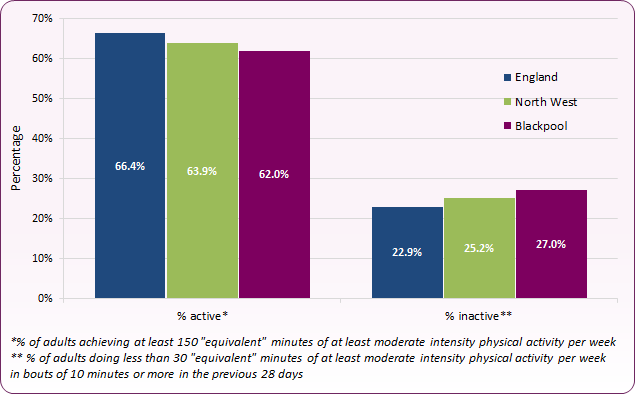 Source: PHE Physical Activity Profile, based on Sport England Active Lives Survey data.
Source: PHE Physical Activity Profile, based on Sport England Active Lives Survey data.
Initial Active Lives survey data for May 2020/2021 (during the first Covid lockdown) also suggests that activity levels amongst Blackpool residents fell steeply, whilst the proportion of inactive residents (undertaking less than 30 minutes activity per week) increased at rates higher than both the North West and England. This suggests that Covid-19 lockdown periods may have impacted more significantly on Blackpool residents' physical activity, and in turn physical health, than in some other areas of the country.
Physical activity that can be incorporated into everyday life, such as brisk walking and cycling, has been found to be as effective for weight loss as supervised exercise programmes. However, over a third of adults report they are not currently active at recommended levels. Active Lives survey data for 2019/20 found that of those who were considered inactive (less than 30 minutes activity per week), 57.1% of Blackpool residents surveyed had undertaken no activity in the last 28 days, compared to 61.8% nationally. More accurate objective measurements show that the true proportions of people who are insufficiently active is likely to be much higher than this.
Creating an environment where people actively choose to walk and cycle as part of everyday life can have a significant impact on public health and may reduce inequalities in health. It is an essential component of a strategic approach to increasing physical activity and may be more cost-effective than other initiatives that promote exercise, sport and active leisure pursuits.
Walking is the most likely way all adults can achieve the recommended levels of physical activity6 and walking for at least 10 minutes on at least five days a week suggests regular walking. Studies have shown that the physical health benefits associated with cycling include reduced risk of coronary heart disease, cancer, stroke and type 2 diabetes. In addition active travel can improve mental wellbeing in a number of areas such as concentration.7
PHE estimates based on Active Lives Survey 2019/20 data (figure 3) indicate that in Blackpool, only 11.1% of residents walk at least three times per week for 10 or more minutes, significantly lower than the national average of 15.1%. Only 1.2% cycle at least 3 times per week, not significantly different to the national average of 2.3%.
Figure 3: Proportion of adults walking and cycling regularly, Blackpool, the North West and England: 2019/20
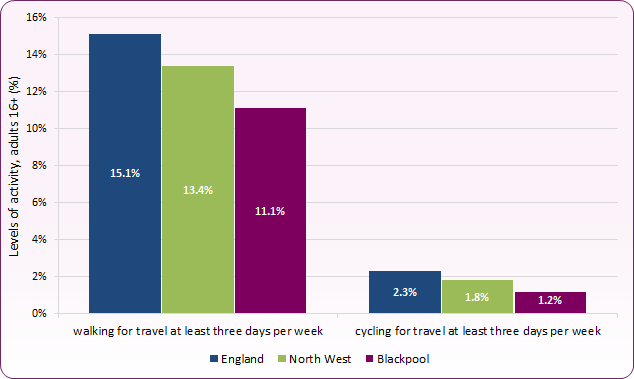 Source: PHE Physical Activity Profile (Dept for Transport; Sport England Active Lives Survey)
Source: PHE Physical Activity Profile (Dept for Transport; Sport England Active Lives Survey)
Sport England's Active Lives Online Tool provides a profile of up-to-date data for Blackpool, covering sports participation, facilities, health, economic and demographics.
Children
Engaging in physical activity is important for children in the short-, mid- and long-term. Physical activity for children is critical for motor development, cognitive improvement, psychosocial health, and cardio-metabolic health; reduces body fat and can increase academic achievement.8 Chief Medical Officer guidelines for physical activity among under 5s and 5 to 18-year olds were refreshed in 2019, with the target for those aged 5-18 years to be physically active for an average of at least 60 minutes per day across the week (figure 4)2.
Figure 4: Physical activity guidelines for children and young people (5-18 years old)
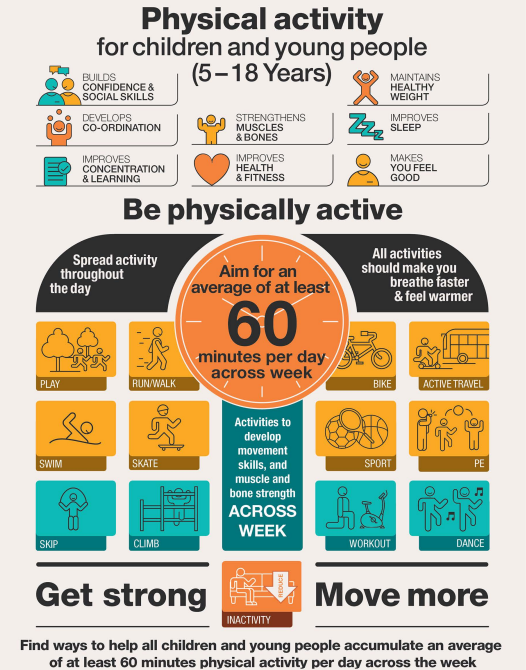 Source: Department of Health and Social Care et al, UK Chief Medical Officers' Physical Activity Guidelines, 2019.
Source: Department of Health and Social Care et al, UK Chief Medical Officers' Physical Activity Guidelines, 2019.
There are very limited sources of regular physical activity data at local authority level for children, with the Active Lives Children and Young People Survey being the only available data source to inform decision-making. This survey takes place via schools among those aged 5 to 16 years of age. It should be noted that due to potentially small numbers in some areas or demographic groups, and missing data over different periods of the year, comparisons based on this information should be treated with caution: there have been significant variations in reported figures for Blackpool over consecutive years. Comparisons with pre- and current Covid-19 periods may also be difficult to draw out with confidence at a local level.
Active lives data for the 2019/20 academic year (which includes part of the Covid-19 period) suggests that 36.1% of 5-16 year olds in Blackpool met the 60 minutes per day average activity guidelines, significantly lower than the 44.9% national level. 40.5% of children and young people in Blackpool were active for less than 30 minutes per day, compared to 31.3% nationally (figure 5).
Figure 5: Activity levels of children aged 5-16; Blackpool, North West and England, Active Lives Survey, 2019/20 academic year
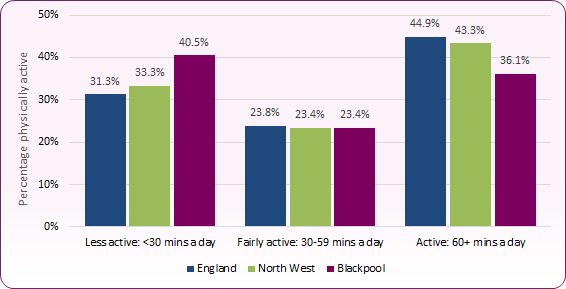 Source: Sport England, Active Lives Children and Young People Survey, 2019/20
Source: Sport England, Active Lives Children and Young People Survey, 2019/20
Weighted estimates by Sport England suggest that this equates to approximately 5,900 5-16 year olds in Blackpool meeting CMO-recommended activity levels, with 10,500 below that level (6,700 of whom are active for less than 30 minutes per day). The survey breaks down the activity levels for those considered less active in more detail (figure 6), showing higher proportions in Blackpool of 5-16 year olds who do not exercise at all (24.6% of those less active compared to 21.2% nationally), or who only exercise for an average of 1-14 minutes per day (35.8% compared to 34.1% nationally).
Figure 6: Proportion of 'less active' (<30 minutes average per day) 5-16 year olds activity levels; Blackpool, North West and England, Active Lives Survey, 2019/20 academic year
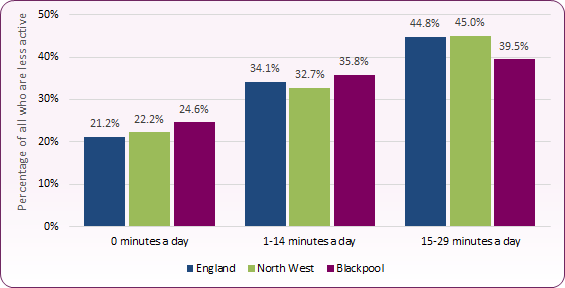 Source: Sport England, Active Lives Children and Young People Survey, 2019/20
Source: Sport England, Active Lives Children and Young People Survey, 2019/20
The 2019/20 survey findings also show that:
- 27.2% of 5-16 year olds in Blackpool were estimated to undertake an average of 30+ minutes a day physical activity during school hours in 2019/20, a reduction from 36.1% in 2018/19. This is compared to 41.6% across England for 2019/20 and 40.4% in 2018/19.
- 49.8% were estimated to undertake an average of 30+ minutes a day physical activity outside of school hours, compared to 54% across England.
- 16.7% of Blackpool's 5-16s exercised indoors for 30+ minutes per day, similar to the England average of 18.4%. However, 47.9% exercised for 30+ minutes per day outdoors, considerably lower than the England level of 57.2%.
- 75.8% of Blackpool's 5-16s are estimated to be able to swim, compared to 83.7% across England. 55.1% are able to swim 25 metres unaided, compared to 63.7% across England. The ability to swim correlates to deprivation, with 84.2% of those from affluent families being able to swim 25 metres nationally compared to 41.3% among those of low family affluence.5
In addition to the Active Lives Survey, a healthy lifestyle survey9 was carried out in 2019 by the Schools Health Education Unit (SHEU) in primary schools (children aged 8-11 years) and secondary schools (children aged 12-15 years). Figures are compared with the previous survey undertaken in 2017:
In primary schools
-
- 83% of pupils reported that they enjoy physical activity 'quite a lot' or 'a lot' (85% in 2017)
- 59% describe themselves as 'fit' or 'very fit' (64% in 2017)
- 39% reported that they had done exercise which made them breathe harder and faster five times or more in the week before the survey (41% in 2017)
- 44% of pupils walked to school on the day of the survey, 53% came by car (50% and 45% in 2017)
- 79% of pupils said they had a bicycle (80% in 2017)
In secondary schools
-
- 60% of pupils reported that they enjoy physical activity 'quite a lot' or 'a lot' (64% in 2017)
- 45% of boys described themselves as 'fit' or 'very fit', compared with 37% of girls (43% and 36% in 2017)
- 54% of pupils reported that they had done some form of physical activity on at least three days in the week before the survey, 7% said they had not done any (58% in 2017)
- 36% of pupils had exercised enough to increase breathing rate on at leastthree3 days in the week before the survey, 20% said none (33% in 2017).9
Risk factors
Despite the well-documented evidence of the benefits of leading a physically active lifestyle, the vast majority of the UK adult population is not active at levels to confer health benefits. Activity levels amongst children and young people are also low.
There are significant inequalities in levels of physical activity in relation to geography, age, gender, ethnicity, socio-economic status, sexual orientation, gender identity, and disability.3 In the UK:
-
- Physical activity levels are low amongst adults, particularly women.
- Physical activity declines rapidly with increasing age for both men and women, and drops markedly in those aged over 75 years
- Physical activity levels are low in children, with girls being less active than boys.
- Physical activity levels decline in both girls and boys with increasing age, but this occurs more steeply in girls as they move from childhood to adolescence
- Children from lower socioeconomic groups and some black, Asian and minority ethnic groups are less physically activity than their counterparts from higher socioeconomic groups.
- Data for 2010 showed that schools were meeting the 2 hours of PE requirement as measured by the School Sports Partnership (SSP). However, the SSP no longer exists as a national strategy so it may become harder to monitor activity levels in schools. The Department for Education currently recommends at least 90 minutes per week PE provision, but does not stipulate what counts towards this provision (so, for example, travel to and from venues may be included).
- Individuals with disabilities/living with long-term conditions are less active.
- With levels of obesity predicted to increase, physical inactivity levels may increase as a result, as there is evidence that overweight/obese individuals have lower levels of physical activity.
The Department for Culture, Media and Sport (DCMS) Strategy; 'Sporting Future: A new Strategy for a Healthy Nation' also identifies four under-represented groups who sit significantly below the national average in achieving the guidelines on physical activity:
-
- Women and girls
- Lower socio-economic groups
- People with a limiting illness or disability
- 65 years and over
Current services in relation to need
A number of core sport and physical activity programmes and services are provided to support the needs identified locally. The Active Blackpool Exercise Referral Programme provides a pathway to support individuals to lead a healthier lifestyle through sport and physical activity. The programme allows GP's and practice nurses to refer individuals who they have identified would benefit from leading a healthier lifestyle. The programme provides a range of activities and opportunities and received 1,270 referrals and more than 65,000 attendances in 2018/19.
A Steps to Health walking programme operates across Blackpool, providing free opportunities for individuals to be active in a social environment. The programme saw 2,782 attendances in 2019/20, this was impacted by COVID-19.
Get Out Get Active (GOGA) is a three-year programme delivered across the UK which supports the least active disabled and non-disabled people to enjoy being active together. The programme is being delivered in partnership with Blackpool Coastal Housing and supported by Active Lancashire.
The School Games programme is a national initiative aimed at increasing the range and quality of sport and physical activity opportunities and competition for children and young people in primary and secondary education. The programme provides a broad range of opportunities and engaged 14,913 individuals in 2019/20.
The Sport4Champions programme is delivered within 30 educational settings (compared to just 14 in 2019) and engaged with 1,602 children in 2021.
A number of externally funded short term projects aimed at 14-25 years olds are delivered locally. The projects have a number of aims including: reducing anti-social behaviour, engaging individuals within identified geographical wards and encouraging inactive individuals to become active.
Active Blackpool continues to develop the community provision. The range of activities delivered as part of the Active Communities Service provides opportunities for children, young people and adults of all abilities in a host of programmes including Man V Fat, Multi-Sports, Street Games, Rounders, Wheels 4 All, Balance Bikes, Cycling, Walking Sports and Tennis. The audiences for these programmes come from local community groups including Warren Manor, Bristol Avenue and Headway along with open access programmes where engagement is encouraged from all community areas.
In Summer 2021 Active Blackpool began the delivery of a three-year Inclusion Programme funded by Blackpool Council SEND team. The programme offers opportunities for children and young people with mild/moderate additional needs to participate in a range of sports and activities. A five-week programme was delivered at Blackpool Sports Centre and the programme was a success, engaging with 168 children.
The Get Out Get Active programme has something for everyone, and a range of activities have been delivered within the local community including:
-
- Buggy Walks with Better Start in Bloomfield
- Health Walks from South Shore Hub and Kincraig Lake
- Ping & Table Tennis at Blackpool Coastal Housing Roadshows
- Boxing with William Lyons House
- Badminton and Wheels for All with the Stroke Association
- Climbing sessions with N-Vision.
Active Travel - Active Blackpool’s Active travel Team are working with National Partners, Living Streets and Cycling UK to develop a number of walking and cycling initiatives in Blackpool. The Active Travel team will work with local schools, businesses and community groups to promote active travel.
Learn to Swim - Active Blackpool’s stated goal is to provide opportunities for children, young people and adults of all ages, abilities and backgrounds to develop a lifelong relationship with the water by providing high quality, professional swimming lessons in a fun, safe environment. The after-school LTS programme attracted 48,000+ attendances in 2018/19.
Unmet needs and service gaps
As highlighted by the Active Lives Survey 2019/20 (above), a considerably higher percentage of the Blackpool population is estimated to be inactive (27%) compared to the North West (25.2%) and England (22.9%). Children and young people are also significantly less active than their counterparts in the North West and England.
A 2015 report by the LSE, Moving the Goal Posts: Poverty and Access to Sport for Young People10, found that young people in areas of poverty are significantly less likely to participate in sport because of the cost of taking part. A gap in provision currently exists in targeting 14-25 year olds living in deprived areas to support them in continuing to lead an active lifestyle as they leave full-time education and Sport England has identified a drop off in sport and physical activity engagement with this age group across England.
The strategy also identifies the potential opportunity and latent demand for outdoor recreation. Sport England and the Outdoor Industries Association (OIA) recently published Getting Active Outdoors, a detailed study into both the supply and demand for outdoor activities in England. It showed that of the 43.7m adult population, 18.2m who are not currently active outdoors want to re-engage in outdoor activity in the next 12 months. Blackpool has the potential to provide a number of outdoor recreational opportunities for a variety of populations and target groups, utilising the existing natural space across the town, with the potential to focus on developing Stanley Park as a key destination for a range of outdoor recreation activities.
National and local strategies
'Everybody active, every day' is a framework, produced by Public Health England (PHE), for national and local action to address the national physical inactivity epidemic. To make active lifestyles a reality for all, the framework's four areas for action will:
-
- change the social 'norm' to make physical activity the expectation
- develop expertise and leadership within professionals and volunteers
- create environments to support active lives
- identify and up-scale successful programmes nationwide
The Strategy; 'Sporting Future: A new Strategy for a Healthy Nation' aims to tackle head-on the flatlining levels of sport participation and high levels of inactivity in this country. Through this strategy, government is redefining what success in sport means, with a new focus on five key outcomes: physical wellbeing, mental wellbeing, individual development, social and community development and economic development. In future, funding decisions will be made on the basis of the outcomes that sport and physical activity can deliver. Furthermore, this strategy will extend the remit and focus of Sport England from 14 years and over, to 5 years and over, outside of an educational setting. Recognising the need to engage and form a habit from a younger age, to ensure the lifelong benefits of physical activity are recognised.
Active Blackpool’s Active Lives Strategy launched in January 2021. This Strategy sets out the strategic direction for physical activity, sports and active lifestyles in the Authority over the next five years (2021-2026).
The ambition of Blackpool Council (BC) is that this Strategy:
-
- Maps a high-level strategic vision for active lives in Blackpool centred upon the needs of the community; in particular parts of the community where there are more people who are inactive.
- Covers indoor and outdoor sports, physical and recreational activity and active travel.
- Is intelligence-led, supports locally identified priorities and reflects the renewed ambition and positioning of the area.
- Interfaces, and has clear synergy, with current national and local stakeholder strategies/ priorities while also delivering value for money for the Council.
- Is underpinned by a partnership approach between the Council, the community and other partners delivering sport/physical activity and wider wellbeing provision. The ambition stated will be fulfilled via work with the community and partnership with providers and organisations that can each play a key role in the delivery of its aims.
- Is based upon comprehensive engagement and consultation with council officers and members, local community organisations, clubs and national governing bodies of sport (NGBs).
- Will be developed (and implemented) iteratively, and in collaboration with local members who will sit within a steering group.
- Determines priorities and measurable targets - the progress made against which Blackpool Council and partners will be evaluated (and judged) over the five-year period covered.
[] PHE, Physical Activity Profile. Data is based on Sport England Active Lives adult and children and young people's surveys. Note: calculations for activity and inactivity are based on weighted numbers of respondents and may differ from those presented by Sport England due to differences in age and physical activity inclusion criteria.
[] Department of Health & Social Care, 2019. UK Chief Medical Officers' Physical Activity Guidelines, September 2019.
[] Public Health England, 2014. Everybody active, every day: an evidence-based approach to physical activity.
[] PHE / ICF Consultancy, 2021. Everybody active, every day: 5 years on.
[] Sport England Active Lives Survey, November 2019/2020.
[] NICE Guidance [PH41] Physical activity: walking and cycling. November 2012
[] NICE News article Commuting by walking or cycling can boost mental wellbeing, September 2014
[] Office of National Statistics (ONS), 2016. Health survey for England 2015: Physical Activity in Children
[] Blackpool Council/SHEU. Supporting the Health and Wellbeing of Young People in Blackpool, 2019
[] Edwards, Gwenno, Grubb, Ben, Power, Anne and Serle, Nicola (2015) Moving the goal posts: poverty and access to sport for young people. CASEreports (95). Centre for Analysis of Social Exclusion, London School of Economics and Political Science, London, UK. Available at https://sticerd.lse.ac.uk/dps/case/cr/casereport95.pdf.